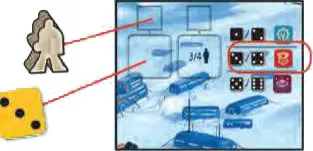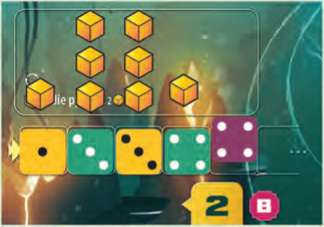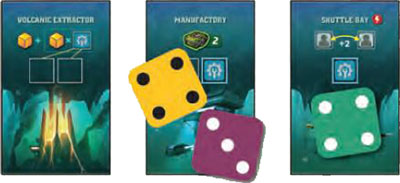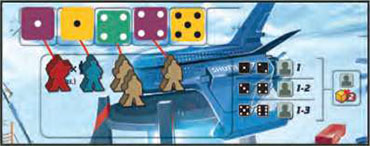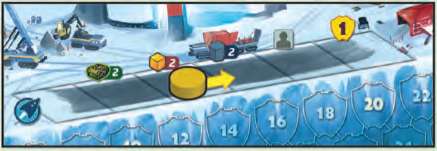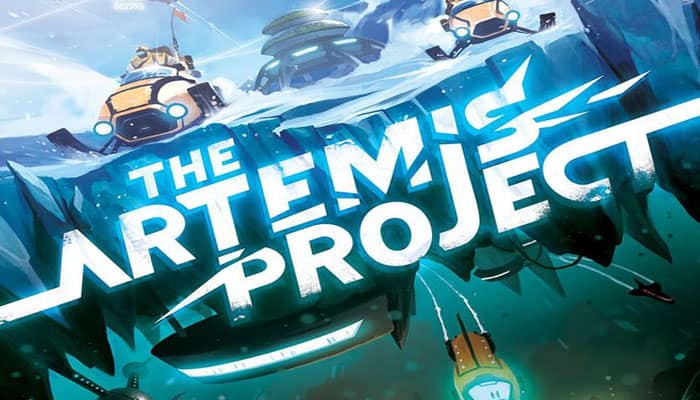
The Story
Europa: the frozen moon of Jupiter. It took decades to bio-form this ball of ice into a place that can just barely support human life... but the effort was worth it to get to the great living oceans below.
With the "'Threshold" energy shield holding in the warming atmosphere, and the "Doorstep" spaceport fully active, teams of Stabilizers descend to compete for leadership of this hostile moon.
The submerged cavern we call The Pocket conceals all the raw materials you'll need to succeed: the hidden oceans are warmed by thermal vents and teem with alien sea life beyond our wildest dreams.
Build your colony under the ice, explore the surface and the seas beneath, and prove that you have what it takes to build this new home for humankind.. the Artemis Project begins!
Object of the Game

You are the head of a team of Stabilizers attempting to build the most successful colony before the game ends.
Harvest resources (Energy and Minerals), construct buildings (in the ocean to improve your abilities and above the ice for scoring), gain and train colonists to staff your colony and help with expeditions.
You will score Victory Points (VP) for various accomplishments during the game, and then for a variety of criteria when the game ends. The player with the most VP wins!

Components
- 1 Game Board
- 5 player mats
- 52 building tiles
- 14 event cards
- 22 expedition cards
- 84 colonist markers
- 1 draw bag
- 25 dice
- 10 player markers
- 60 minerals markers
- 1 event marker
- 1 phase marker
- 35 toolkit markers
- 35 expedition badges
- 20 "5x" tokens
Setup
General Setup

1 Place the game board centrally. Make supply piles of Minerals, Energy, Toolkits, Expedition badges, and 5x tokens by the board as shown.
2 Place 4 each of Engineers, Marines, and Stewards on the board near the Academy.
3 Set aside 1 Pioneer per player, then put the rest of the colonists into the draw bag and mix well; keep it near the Doorstep.
4 Shuffle the Building tiles into separate face-down stacks of Surface and Ocean tiles, and place the stacks near the Gantry.
For a 2-playergame, you must remove all duplicate buildings from both stacks. They are marked with a symbol.
5 Shuffle the Event cards, and draw six to form a face-down Event deck near the board. Return the rest to the box. Put the Event marker near the deck.
Since there are six rounds in the game, this Event deck will act as a game timer to remind you of how many rounds remain.
6 Shuffle the Expedition deck and place it face-down near Basecamp.
Player Setup

1 Each player takes a player mat, both player markers, and all 5 dice in their color.
2 Each player takes 3 Minerals, 3 Energy, and 1 Toolkit from the supply and puts them in the storage areas of their player mat.
3 Each player takes 1 Pioneer colonist (the ones left out of the bag during General Setup) and puts it in their Shelters.
4 Each player places their two player markers on the starting spaces of the Score track and the Relief track on the game board.
5 Select a starting player randomly, and give them the Phase marker.
Board Setup
This process happens at game start and then to prepare for each new round. Obviously, at game start there will have been no "previous round"

1 Basecamp: Clear all Expedition cards from the previous round into a discard pile, then lay out Expedition cards from the deck face up; 1 fewer than the number of players. If the deck runs out, shuffle the discard pile to form a new deck.

If there are any colonists as rewards on these cards, draw them from the bag and place them on those Expeditions now.

If there are any buildings as rewards on these cards, draw them from the stack matching the round you are entering and place them by those Expeditions now.
2 Vents: Discard any Energy remaining from the previous round. Add Energy from the supply to the Vents. The amount you  should add is displayed on the top left corner of all of this round's expedition cards combined, plus 2 energy.
should add is displayed on the top left corner of all of this round's expedition cards combined, plus 2 energy.
3 Quarry: Discard any Minerals remaining from the previous round. Add Minerals from the supply to the Quarry. The amount  you should add is displayed on the top left corner of all of this round's Expedition cards combined, plus 2 Minerals.
you should add is displayed on the top left corner of all of this round's Expedition cards combined, plus 2 Minerals.
4 Gantry: Reveal Building tiles from the indicated stack (Ocean if you are about to play round 1, 2, or 3; Surface if you are about to play round 4, 5, or 6); equal to the number of players. Display them by the side of the board, adding to any that remain from the previous round.
Maximum 8 buildings in the Gantry. If you reach 8, stop revealing new ones.
5 Doorstep: Place random colonists (two more than the number of players) drawn from > the bag into the Doorstep, adding to any that remain from the previous round.
Maximum 12 colonists in the Doorstep. If you reach 12, stop drawing new ones.
6 Academy: No extra setup necessary.
! Outfitters: No extra setup necessary.

Event: Reveal the top card of the Event deck. There is a letter on the Event card; place the Event marker on that letter along the edge of the game board.
This indicates when that Event will trigger during the round. (If the letter is , it triggers immediately when revealed). Read the Event card aloud so that all players are aware of what it will do and when it occurs during the round.
When all of this is complete, you are ready to begin the round!
Harsh Mode
It's supposed to be difficult to colonize Europa... if you find it too forgiving, try a play where you don't add the +2 Energy, Minerals, and Colonists to the Vents, Quarry, and Doorstep in Setup or each round.
Game Play
Each round has a Placement phase where players assign their dice to any of the 7 different regions on the board, then a Resolution phase where the regions (and this round's Event) are resolved in a specific order.
Finally, there is an Upkeep phase to finish the round and prepare for the next one. The game plays for 6 rounds, and then final scoring is calculated and added to VP that players earned during the game.
Some General Rules
Whenever you gain/lose VP for any reason, move your marker on the Score track to reflect the gained/lost points.
Whenever you "pay" or "spend" anything in the game, it is discarded back into its supply pile.
"Resources" refers to Minerals and Energy in any combination.

If the supply runs out of Energy, Minerals, Toolkits, or Expedition badges, players should use the 5x tokens to make change and return resources to the supply. A 5x token kept in one of the storage areas on your player mat counts as 5 of that area's item.
Colonists may only ever go into your buildings if there is room. A building has room for a colonist if there's an empty spot indicating that type of colonist, or an empty blank spot, (which can hold any type of colonist).
Whenever you gain a colonist for any reason, it may immediately be placed in any building that has room, otherwise it must go into your Shelters.
Whenever you gain a building for any reason, you may immediately move colonists from your Shelters (but not from other buildings) into the new building. Colonists may not otherwise be moved around until the move/swap step of the Upkeep phase.
If the draw bag ever runs out of colonists, collect the ones that have been discarded from the game and replenish the bag with those. If ever the bag is empty and there are no discarded colonists, no new colonists may enter the game by any means.
If you are ever instructed to lose something you don't have, comply as much as you can and ignore the remainder. For example, if an event would cause you to lose 2 Minerals and you only have 1, lose the 1.
The Placement Phase
All players roll their dice to form their own dice pool, then placement begins. Begin with the start player and proceed clockwise. On your turn, select one die from your pool and play it to one of the seven regions.

If you have any Toolkits, you may spend them to alter your dice (before you place them, never after).
- Each Toolkityou spend allows you to add or subtract lfrom one die.
- You may spend multiple Toolkits to alter a die multiple times.
- You may not reduce a die below 1 or raise it above 6.
- Basecamp
- Vents
- Quarry
- Gantry
- Doorstep
- Academy
- Outfitter
1. Basecamp
Compete to earn Expedition badges and the rewards shown on the Expedition cards.
Place your die next to the Expedition card you wish, starting at the card bottom. Subsequent dice will be placed above existing dice, regardless of their value.
You are trying to have the combined dice total on an Expedition meet or exceed its difficulty, in order to earn a badge and a reward.
For example, if you wanted to join this Expedition, you would place your die above the die that an earlier player placed at the bottom of the card.
Sending Colonists on Expeditions
You may send along a colonist (or multiple Pioneers) from the Shelters on your player mat (by spending 1 resource) which will help affect the outcome of the Expedition in the manner described below. When sending colonists on Expeditions, place them alongside your die so that it remains clear who owns them.
-

Pioneers: You may send multiple Pioneers with your die. (It only costs 1 resource to send any number of Pioneers from your Shelters). Each Pioneer raises the value of your die by 1 (even beyond 6 is allowed).
Do not change the die itself, just consider each Pioneer to be an added "pip" on your die.
-

Engineers: You may send 1 Engineer with your die. If the Expedition is successful, gain any 2 resources in addition to any other rewards the Expedition might earn you (even if you don't qualify for a reward).
-

Marines: You may send 1 Marine with your die. Immediately reduce 1 opponent's die on the same Expedition by 1 or 2 (actually change the die). You may not reduce a die below 1.
-

Stewards: You may send 1 Steward with your die, and your die must be value 1 or 2 only. If the Expedition is a success and you are the first to choose a reward, gain 1VP in addition to the reward.
Note: This is hard to pull off; you would almost always need to send another die on the Expedition in order to achieve first place and qualify for the Steward's reward.
For example, you could send 2 Pioneers from your Shelters along with your die, by spending 1 Energy or 1 Mineral. You place the Pioneers beside your die, and now that die is considered to be a "7".
2. Vents
Harvest Energy, which is useful for gaining, sheltering, and deploying colonists. This region uses the Exposure mechanism, which is a key element of the game; place your die to the right of all existing dice that are equal to or lower than your die. Your die's value indicates how much Energy you will be able to harvest during Resolution.
3. Quarry
Harvest Minerals, which are used to construct buildings. The Quarry uses the Exposure mechanism, which works the same as in the Vents.
4. Gantry
Bid upon the buildings you wish to construct.
Place your die on the building tile you wish to construct. The value of the die you place here is the amount of Minerals you are bidding to construct the building.
You may place a die onto a building that already has other dice on it, but your die's value must be higher than each other die already there.
You may outbid yourself, or outbid another player who has outbid you.
You do not need to possess the bid amount of Minerals when you place your die; but if you don't own them by the time the Gantry is resolved in the Resolution phase, you won't be able to buy the building. Plan ahead!
For example, if you wanted to place this "4" on a building, you could place it on the Volcanic Extractor, which has no dice on it, or the Manufactory, which has a "3" on it. You could not place it on the Shuttle Bay, since your die wouldn't be the highest one there.
5. Doorstep
Recruit incoming colonists to staff your colony's buildings and assist with expeditions.
The Doorstep uses the Exposure mechanism, which works the same as in the Vents and the Quarry. Your die's value indicates how many colonists (at most) you will be permitted to recruit from the Doorstep during Resolution, at a cost of 2 Energy apiece.
You do not need to possess the needed Energy when you place your die; but if you don't own it by the time the Doorstep is resolved in the Resolution phase, you won't be able to recruit your desired colonists.
6. Academy
Train colonists for other roles
There are only two spaces here (only 1 space in 2p). Place your die along with any type of colonist from your Shelters or from one of your buildings. Your die value determines what your colonist will become, as displayed on the board.
If the Academy has run out of the colonist type you'd train into, placing that die here will result in a wasted action during Resolution.
If you place this "3" in an Academy spot with a colonist, it will become a Marine during Resolution.
Outfitter
Gain Toolkits, which are used to change your dice.
The Outfitter is unique among the regions because it triggers immediately instead of waiting for the Resolution phase!
Place your die in the section here according to the value shown. Immediately gain the amount of Toolkits displayed from the supply and store them in the Toolkit storage area of your player mat.
There is no limit to the number of dice that may be sent to the Outfitter. When all players have run out of dice, the Placement phase ends.
The Resolution Phase

Beginning with the Phase marker at Event Spot A and proceeding clockwise around the board, the 6 numbered regions (and the round's single Event, wherever it may fall) are resolved.
The start player moves the Phase marker around the board to indicate the currently resolving region. All players gain their dice back from regions as they are resolved.

The Event
When the Event marker is reached by the Phase marker, resolve the Event text of the current Event card; read the card aloud and follow its instructions.

1. Basecamp
Resolve each Expedition card separately, beginning with the one closest to the deck and proceeding away from it.
If the combined total of all the player dice by the card is lower than the Expedition difficulty, the Expedition has failed; every player with dice there receives nothing and gains 1 on the Relief Track (see Relief Track below).
If the combined total of all the dice by the card equals or exceeds the Expedition difficulty, the Expedition is successful!
The player with the highest combined value of their own dice (plus any Pioneers) gains 1 Expedition badge and picks a reward from the two shown on the card. The player with the second-highest value of dice there gains 1 Expedition badge and receives the remaining reward. Any other player with dice there receives nothing and gains 1 on the Relief Track.
Ties are broken by the player who played to the Expedition earlier, which is the die placed lower beside the card.
If only one player has dice present on a successful Expedition, that player gains both rewards (but only one Expedition badge).
Remember to account for colonist abilities as you resolve! After each Expedition is resolved and rewards claimed, your colonists return to your Shelters (or to your Expedition Hub building, if you have one), not to any other building.
For this Expedition, Green has 6, Yellow has 7 (5 plus 2 Pioneers), and Purple has 3. The total is 16, which easily beats the difficulty of 8; the Expedition is a success!

Yellow gets a badge and picks a reward first, choosing to take the Pioneer and Engineer. Green gets a badge and the remaining reward: a single VP.
Purple earns neither a badge nor any reward, and gains 1 on the Relief Track.
2. Vents
Beginning with the leftmost die and proceeding right, the owning player takes Energy from the Vents equal to the die's value.
(It is possible that a die will result in a player receiving only some of the Energy their die should have earned them; in that case the player should take as much as possible, and the leftover value of the die is wasted).
For any die that earns zero Energy because the Energy ran out, that die is exposed and earns nothing; the player gains 1 on the Relief Track.
For example, there are 8 Energy and these 5 dice in the Vents.
- The Yellow 1 takes 1 Energy.
- The Green 3 takes 3 Energy.
- The Yellow 3 takes 3 Energy.
- The Green 4 takes 1 Energy because that's all that remains.
- The Purple 4 is exposed, so Purple gains 1 on the Relief Track.
3. Quarry
Resolve identically to the Vents except with Minerals.
4. Gantry
Resolve each building tile (that has any dice on it) separately. The player with the highest-value single die has the option to pay that much in Minerals in order to claim that building tile.
That player may opt to not spend the Minerals to buy the building (or may not have enough Minerals to spend); that player does not gain anything on the Relief Track. In this case the option goes to the player with the next-highest value die, and so on.
If you were outbid by another player (not yourself) and that player does pay for and claim the building, you gain 1 on the Relief Track.
When you claim a building, line it up beside your player mat according to whether it is an Ocean or Surface building. Remember: when you gain a building, you may immediately move any colonists you wish from your Shelters to that building if there is room.
Nobody bid on the Volcanic Extractor. Yellow won the bid for the Manufactory, so pays 4 Minerals and claims the building. Purple was outbid, so goes to the Relief track.
Green wins the bid for the Shuttle Bay without a fight, so pays 4 Minerals and takes it.
5. Doorstep
Beginning with the leftmost die and proceeding right, the owner may pay 2 Energy per colonist to claim colonists of their choice from the Doorstep, as limited by the die value (shown on the board).
If the colonists run out before all dice have been resolved, any unresolved die gains its owner 1 on the Relief Track. (You may opt out of taking any colonists even if some remain, but you do not gain on the Relief Track unless there are no colonists in the Doorstep when it is your die's turn to resolve).
When you gain a colonist, you may immediately place it into any of your own buildings where you have room, otherwise it goes into your Shelters.
These are the dice and colonists in the Doorstep. Players pay 2 Energy per colonist in this order:
- Purple claims 1 colonist: the Marine.
- Yellow claims 1 colonist: the Engineer.
- Green claims 2 of the Pioneers.
- Purple claims the last Pioneer.
- TRe Doorstep is empty, so Yellow's 5 earns Yellow a trip to the Relief Track.
6. Academy
Each player with a die in the Academy discards their placed colonist from the game, and gains the appropriate (according to their die value) colonist from the Academy supply.
(If there are none remaining of the type you should gain, your action here is wasted and you retrieve your placed colonist but you do not gain 1 on the Relief Track).
The Academy space on the left is resolved first when both are filled.
As always, you may immediately place your new colonist into any of your own buildings where you have room, otherwise it goes into your Shelters.
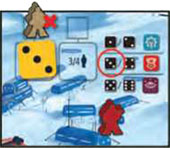
Since Yellow played a "3" into the Academy, Yellow's Pioneer trains up into a Marine!
Yellow discards the Pioneer from the game and takes the Marine from the Academy supply.
Outfitter
The Dice Were Already Resolved During The Placement Phase. Players Simply Take Them Back Now.
 The Relief Track
The Relief Track
Whenever you gain on the Relief Track (usually because you had an exposed die, went on a failed Expedition, or were outbid on a building), move your Relief Track marker 1 space to the right. Then gain the reward shown above the space your marker is in, or any one reward your marker has already passed.
Example: You are on the second space of the Relief Track, and you gain 1; you move to the third space and could choose to gain either 2 Minerals, 2 Energy, or 2 Toolkits.
Once your marker reaches the end of the Relief Track, you no longer move it or gain Relief Track benefits for the remainder of the game, even if you would normally be entitled to do so.
Once the Resolution phase is over, proceed to the Upkeep phase.
The Upkeep Phase
During the Upkeep phase, players perform the following tasks in order.
One Move/swap
Each player may perform 1 colonist move/swap. This means that you may either move a colonist from its current location to an empty space in a building with room (or to your Shelters), or swap the current position of any two colonists in your buildings or Shelters, as long as there is room for both in their destinations.
Activate Fully-staffed Buildings
Each player may activate their fully staffed Ocean buildings. Most Ocean buildings provide some sort of benefit that can be gained at this time, as long as the building is fully staffed (meaning, there are no empty spots).
Players may activate their buildings now (up to once per building) in any order they choose, and gain the benefits described. (See the Building Appendix for details on each building).
Pay Energy for Colonists in your Shelters
For each colonist (of any type) in your Shelters, you must pay 1 Energy to keep them warm. If you don't have enough Energy to pay to warm all of the colonists in your Shelters, pay for as many as you can (your choice which ones get paid for) and discard (from the game) any colonists that are not paid for.
Refresh the Game Board
Each region gets refreshed for the next round (not necessary if the round you just finished was the final round; you can tell that the final round just finished if there are no Event cards left to reveal).
The process for refreshing the board is the same as the original Board Setup on page 4, and is summarized on the back of the rulebook.
Choose a new Start Player
The player with the fewest resources chooses the starting player for the next round. (If this is a tie, the tied player furthest in clockwise order from the previous starting player chooses). Then a new round begins with a new Placement phase.
End of the Game
After the sixth round is complete (including the Upkeep phase), tally final scores to see who has won.
Players may have earned VP during the game, and now they will add to those scores according to the criteria displayed below and on the back of the rulebook. Score them in the specific order below:
-
Saved Energy And Saved Minerals

Earn 1VP for every 5 Energy you have left (up to a maximum of 3VP), and 1VP for every 5 Minerals you have left (up to a maximum of 3VP).
-
Fully Staffed Surface Buildings

Each fully-staffed Surface building in your colony scores VP as described on that building tile. Surface buildings that are not fully staffed do not score.
-
Number of Buildings

Earn VP based on the number of buildings you've constructed, as displayed on the chart. All of your buildings count towards this score whether they are fully staffed or not.
-
Colonist Sets

Earn 3VP for each full set of all 4 colonist types in your colony. You can move all colonists to your Shelters to form sets, they aren't needed in your buildings any more.
-
Leftover Colonists

For every group of 3 colonists in your colony (regardless of type) that were not part of a set above, score 1VP. Ignore remainders.
-
Expedition Badges

Earn (or lose) VP based on the number of Expedition badges you've collected, as displayed on the chart.
-
Most Toolkits

Earn 2VP if you have (or are tied for) the most Toolkits.
The player with the most VP wins!
In the event of a tie, the tied player who went earlier in the turn order in the final round wins!
Continue Reading




